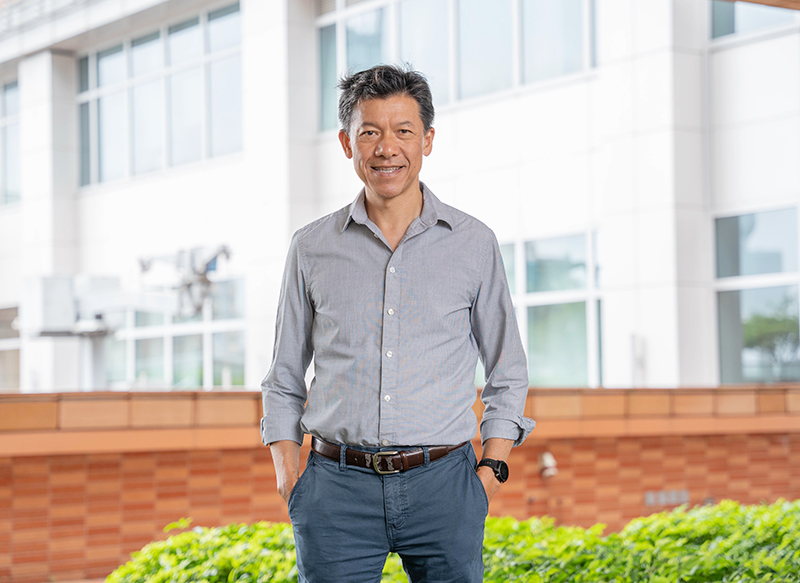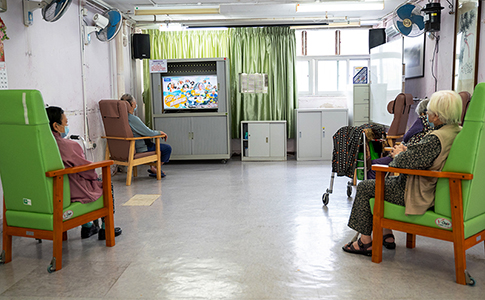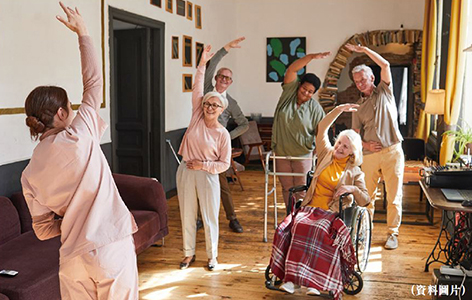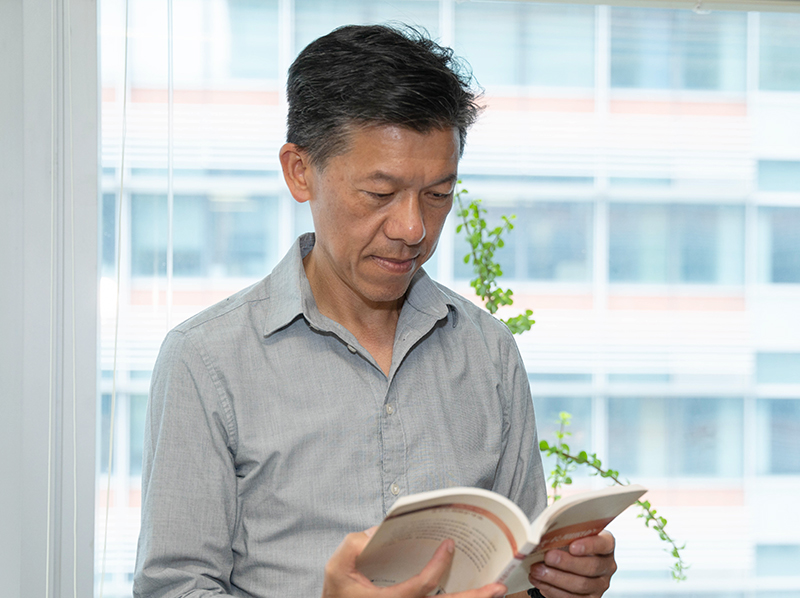Interview with Professor Lum Yat Sang, Terry

Professor Lum Yat Sang, Terry
Department of Social Work and Social Administration, The University of Hong Kong
Looking into the elderly care policy under the pandemic
Elderly homes in Hong Kong still managed to secure the goal of COVID-19 prevention safely before the third wave of pandemic. There had been zero infection in elderly homes until early July in 2020. Nonetheless, Omicron swept over Hong Kong, making it difficult for society to address the situation. Likewise, elderly homes lost control. During the fifth wave, 98% of elderly homes had an outbreak of COVID-19. Death from elderly homes contributed to almost half of the cumulative death. Professor Lum Yat Sang, Terry from the Department of Social Work and Social Administration, The University of Hong Kong, who has been studying elderly welfare policies and long-term care for many years, said, "The policies on pandemic control over the past two years remained unchanged, yet the virus has been constantly evolving."
Why did elderly homes lose control during the fifth wave?
Hong Kong people have learnt a brutal lesson in 2003 because of SARS. Professor Lum commented that the government implemented a series of infectious control guidelines in elderly homes back then in 2004. For example, each elderly home had to appoint a nurse or health workers as infection control officer. When COVID-19 struck, the Social Welfare Department published guidelines to elderly service sectors right away.
However, Professor Lum said, "the whole society had the pandemic under control at an early stage, instead of just the elderly homes." He continued pointing out that the problem lies in how the government dealt with situations in the past, which was to prevent viruses from leaking into elderly homes. This policy only applies to circumstances where the number of infection cases is still small. "The government did not strengthen its ability to deal with a large scale of COVID-19 outburst," said Professor Lum. When isolation wards in hospitals are full, the elderly cannot be admitted into hospitals. "Such a chain effect causes the whole system to collapse," said Professor Lum, who insists on enhancing cooperation between the social welfare sector and the healthcare sector.
Making good use of telehealth and allowing registered nurse to prescribe medications
Professor Lum reckoned that a COVID-19 outbreak is inevitable as the virus has high transmittance. Therefore, the key is to consider measures to be taken after infections, such as telehealth which can alleviate the pressure on hospitals. Professor Lum shared that his mother in law with dementia got infected in mid-March at an elderly home. "On the first day, the Rapid Antigen Test (RAT) showed a positive result. Then, she attended an online appointment with her doctor the next day and received medication in the afternoon. The whole process does not require admission to the hospital." said Professor Lum. He also had a colleague who had cancer before and got infected in Britain. As he received treatment locally before, the National Health Service contacted him the next day after he reported his positive RAT result to the central system. After communicating, medication was prescribed the next day. "This method does not require people who are tested positive to seek help outside and does not occupy hospital beds." said Professor Lum.
Professor Lum also suggested allowing registered nurses in elderly homes to prescribe medicine for common sickness. "There are retail clinics in a lot of malls in other countries. When patients are seeking treatment on common illnesses, nurses prescribe medications in other countries." said Professor Lum. This method could buy time for groups with higher risk. "Why don't we imitate other countries when Hong Kong has the ability to do so?" Professor Lum asked.

Why are old-styled private elderly homes not suitable for weak elderly?
Accident & Emergency rooms in hospitals were fully occupied on 17th February and the government published on-site quarantine guidelines to elderly homes during late night. Nonetheless, there has always been a lack of space and manpower for elderly homes in Hong Kong. Thus, some could only resort to using "below-standard" isolation method. "On-site quarantine is impossible with the current situation of elderly homes in Hong Kong." Professor Lum assertively said.
Since 1996, there hasn't been any major reform in elderly home planning after the government introduced "The Residential Care Homes (Elderly Persons) Ordinance" (The Ordinance) throughout these 20 years. Even after amendments on the Ordinance were proposed in February 2022 to increase the least average living area from 8 to 9.5 square meters, it is still smaller than a car parking space. Moreover, many small and medium-sized private elderly homes are located in tenement buildings or old private buildings. Elevators had to be shared with the rest of the building and there was a lack of fresh air ventilation systems so they are not suitable for the elderly who are physically weak. There are doubts from the community whether old-style private elderly homes should still be kept after the fifth wave of pandemic.
The current non-subsidised private places for elderly occupy 52% of the total number of places, whereas subsidised places account for 41%. Subsidies are given to subvented homes, self-financing homes, contract homes and private homes which participate in Enhanced Bought Place Scheme.
 (stock photo)
(stock photo)
Welfare for elderly is far worse than other countries
"As the government cannot solve the problem of long waiting periods for elderly homes, private elderly homes have emerged. It takes a toll on the quality of elderly homes." Professor Lum pointed out that most private elderly homes in other countries are non-profit making. "Yet, it is really special in Hong Kong; nearly 60% of private elderly homes are profit-making, but 80% of their income comes from the government in the form of Comprehensive Social Security Assistance (CSSA)." When nearly 60% of the residents in private elderly homes are elderly with CSSA, the service quality became equivalent to its price. "Our elderly care policy is unreasonable. Elderly who are not able to queue up for subvented homes are always the poorest and the ignored ones. However, they get the least resources and the environment is no different from partitioned flats." Professor Lum sighed.
In the "2022-23 Budget", around HKD140 million recurring expenses were invested on elderly care services. "Hong Kong may face the Silver Tsunami in 20 years, with escalating inflation of medical services. In face of different factors, the abundance of resources does not rely on numbers only, but is adjacent to the level of societal development." Professor Lum pointed out that the healthcare sector occupies 8% to 10% of the countries’ GDP for other developed countries like Australia and Japan, with 90% of the resources invested in public healthcare. However, the healthcare sector occupies 6.4% only in Hong Kong, which is really low. Worse still, only half of it is invested in public healthcare. "As for elderly welfare, Hong Kong is far lower than other countries as far as retirement protection, healthcare and elderly care are concerned," said Professor Lum.

Muddled services: looking in surplus but insufficient in reality
Professor Lum thought that the root cause of the problem is the insufficient resources invested in elderly services but not the lack of elderly homes. He pointed out that 3% to 4% of elderly live in elderly homes in Mainland China and other countries while 7% of them live in Hong Kong’s, which is nearly the highest globally. "Most of the elderly live alone in Northern America and 10% of the elderly live with or get taken care of by their children. In comparison, there are 400,000 foreign domestic workers in Hong Kong and 50% of the elderly live with their children. The number of elderly living in elderly homes ought to be lower than 4%. Thus, this leads to incompetent policy as there is not enough support that allows elderly to thrive in the community." said Professor Lum.
Professor Lum used to live in the US for more than 10 years and participated in the elderly care research conducted by the US government. In the early 2000s, even though the amount of elderly living in the community was much higher than those under elderly home care, researchers discovered that the government still invested resources in elderly homes and community care in the ratio of 7 to 3. Therefore, the US government grappled with the situation through implementing a series of reforms. Most states have invested over 50% of the resources on community care since then. As for Hong Kong, only HKD4.2 billion (34%) were invested in community care services when the total estimated budget for elderly care services in 2020-21 was HKD12.3 billion.
There are currently different aspects of life in Hong Kong's community care services, from meals, household cleaning, daily care, accompaniment to clinics, to rehabilitation sports, speech therapy. However, some of them lack consistency. Professor Lum described this as "muddled services": it looks really diverse on the surface, "but not the true case when we ask the elderly about their experience." said Professor Lum.
Will elderly homes fully reform after this pandemic? "First, the government has to prioritise people's daily living. Reform is very difficult if we only consider the amount of resources being invested. Although this cannot be achieved in the short term, it doesn't mean we don't have to contemplate it." Professor Lum hesitated.








